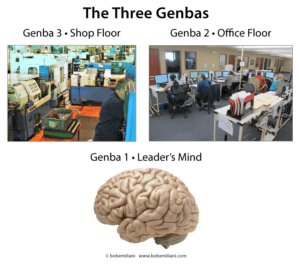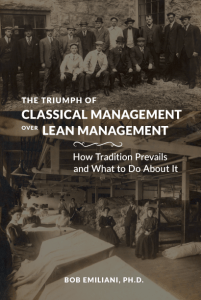
When the world became aware of Toyota’s production system in the mid-1970s, there was one genba — the shop floor. I call this Genba 3. When Lean arrived in 1988, there remained just one genba — the shop floor. Within a few years, office work became recognized as another genba (Genba 2) where large amounts of waste, unevenness, and unreasonableness exist and must be eliminated. Genba 3 and Genba 2 have captured most people’s attention for nearly 45 years. But, Genba 3 and Genba 2 never captured my attention.
Many people think I am a “Lean manufacturing” guy. That’s not true. I never have been. Genba 3 and Genba 2 are interesting, and I do know quite a bit about them — enough to write knowledgeably, based on practical experience and two decades of careful study — but I never considered myself qualified to train or consult in those areas. I am a leadership guy. My focus since the mid-1990s has been Genba 1 — the mind of leaders. For me, Genba 1 is the most interesting genba by far; specifically, leaders’ mindset, thinking, decision-making (including no decision), and actions (including no action). Genba 1 is the most challenging because it does not reveal the truth as easily as Genba 3 and Genba 2. In fact, Genba 1 actively seeks to conceal and subvert the truth, sometimes unknowingly. Genba 1 seems to be an unbreakable enigma, but the code can indeed be cracked.
Because it is so difficult, nearly everyone ignores Genba 1. Still, it is unclear to me why this is so because simple causality informs us that Genba 1 is what allows Genba 3 and Genba 2 to happen or not happen. The fundamental problem that I have long pursued is: “Why doesn’t Genba 1 allow Genba 3 and Genba 2? Related questions include “Why does Genba 1 dislike Lean transformation?” and “Why does Genba 1 limit Lean to the use of certain tools?”
Remarkably, the biggest names in the Lean community have never had any interest in working on this important problem, and a few told me directly that any effort put into this problem is a waste of time; that one should forget about the leaders who don’t care about Lean and focus on the ones that do. My book proves their predictions about such work being a waste of time to be wildly incorrect; this difficult problem was solved as a result of sustained, methodical effort over more than a decade. It is remarkable they would think that working on this problem is a waste of time because they should have learned the following lesson from their decades-long study of Toyota:
- Don’t ignore problems
- Ask “Why?”
- Don’t predict outcomes
- Try it out
- Keep trying; you will find a way
- Don’t give up
I learned this from Shingijutsu consultants in 1995 when I participated in my first kaizens at Pratt & Whitney to improve manufacturing processes in my business unit for making F-100 and F-119 jet engine parts for the United States Air Force. I learned a practical thing, and so I put it to use in my own work.
Since around 2010, people have begun to focus on Genba 1, but that focus has been limited to leadership behaviors. This is where everyone starts in their quest to understand why leaders succeed or fail with Lean. And, leadership behaviors is where people get stuck for years, if not decades. That is unfortunate because leadership behaviors as a description for the cause for Lean transformation failure is only the apparent problem; leadership behavior is not the actual problem. To understand the actual problem, one must dig deeper — much deeper. That is what I have done in my book, The Triumph of Classical Management Over Lean Management.
It is lamentable that people will remain stuck on leadership behaviors for many more years to come despite the existence of new and better information. I believe this is the result of Lean having long ago become divided into different groups that are both polarized and fragmented. That makes it more difficult to solve even larger problems. To do that we must unite our efforts. Is it a waste of time to work on that? I don’t think so. But, efforts to unite will surely depend on whether the biggest names in the Lean community think it is a waste of time. My bet is that they think working on that problem is a waste of time.

